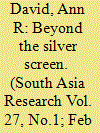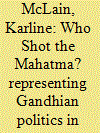| Srl | Item |
| 1 |
ID:
077208


|
|
|
|
|
| Publication |
2007.
|
| Summary/Abstract |
This article first highlights the relative paucity of literature on South Asian dance and provides a brief overview of existing material. It then examines particularly the influence of filmi or Bollywood dance on South Asian dance practices in the UK. It locates film dance within the Bollywood genre, noting its recent acceptance as a new form of popular culture and its attractions for the younger generation of British Asians. The place of dance in Hindi films is analysed and discussed briefly to con-textualise the relationship between such film dances and South Asian dance practices in Britain. Using evidence from fieldwork gathered in Leicester and London amongst dance teachers and students of South Asian dance, the article questions notions of identity, authenticity, tradition and the changing nature of dance transmission as Bollywood forms grow in popularity.
|
|
|
|
|
|
|
|
|
|
|
|
|
|
|
|
| 2 |
ID:
077209


|
|
|
|
|
| Publication |
2007.
|
| Summary/Abstract |
Amar Chitra Katha ('Immortal Picture Stories') is the leading Indian comic book series, with 440 mythological and historical titles and sales of over 86 million issues. In 1989, after twenty years of publishing success, the producers of this series decided to release two issues on the world-renowned Indian politician and activist, Mahatma Gandhi. But Gandhi, best known for his technique of non-violent civil resistance, presented a formidable challenge: How to depict the Mahatma, paragon of peace and non-violence, in a visual medium that is notorious for its action and violence? This article examines the relationship between text and image in these comics, and draws upon interviews with authors and artists, to better understand the contested memory of Gandhi in India today as well as the contested concept of non-violence
|
|
|
|
|
|
|
|
|
|
|
|
|
|
|
|